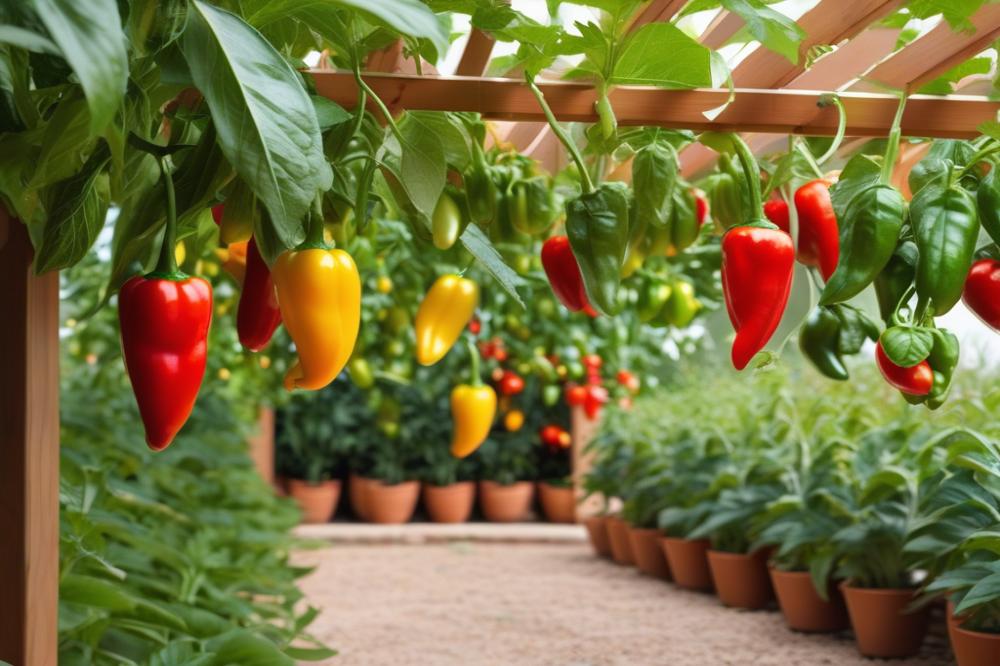Growing Manzano peppers in cooler climates
Manzano peppers are a delightful variety known for their unique flavor and distinct sweetness. These fruits stand out among chill peppers, adding a touch of warmth to various dishes. Growing them, however, can present challenges, especially in regions characterized by cold weather gardening. Despite these obstacles, gardeners can still cultivate these peppers even when temperatures drop. Their vibrant color and taste can brighten any garden, inspiring many to try their hands at outdoor gardening.
It is essential to recognize the importance of cultivating pepper varieties in areas with lower temperatures. Not only does this expand the diversity of home gardens, but it also allows for fresh produce where it might otherwise be impossible. Gardening techniques for cooler climates can include container gardening, which provides flexibility and control over growing conditions. Those interested in growing warm-weather plants will find that proper planning and adaptation yield satisfying results.
This article aims to provide valuable growing tips for enthusiasts seeking to master the art of cultivating these peppers. Topics will include soil requirements, plant care, and effective pest management strategies. Each section will focus on practical, straightforward advice. By following these guidelines, gardeners can successfully grow Manzano peppers and enjoy their unique flavors, even in cooler climates.
Understanding Manzano Peppers


Manzano peppers, also known as Peruvian peppers, are a type of chili pepper that stands out due to their sweetness and slight heat. These fruits are round, resembling small apples, and typically change color from green to yellow or red as they ripen. They grow well in various conditions, but prefer warm temperatures. However, growing them in cooler climates requires careful management.
One unique characteristic of these peppers is their fruity flavor, which can complement both spicy and savory dishes. Many people find that their taste is richer compared to other pepper varieties, like jalapeños or bell peppers. The heat level is moderate, measuring around 30,000 to 50,000 SHU on the Scoville scale. This means they can add a pleasant kick without overwhelming a dish.
Comparison to Other Pepper Varieties
When you compare Manzano peppers to other chill peppers, the difference in appearance and flavor becomes evident. For instance, jalapeños tend to be more elongated, while Manzano peppers are round and stocky. Both types have their uses; however, Manzano peppers are less common in supermarkets. This difference can make growing tips for these peppers even more appealing for adventurous gardeners.
Another factor is their adaptability. While many pepper varieties thrive in warm climates, Manzano peppers can still produce a decent yield in cold weather gardening. Employing proper gardening techniques allows for successful outdoor gardening, even with unexpected temperature drops. It’s important to consider soil requirements and choose a location with maximum sunlight exposure.
Container gardening is also a great option for those in cooler regions. Using pots allows you to move the plants indoors during chilly nights. This helps protect them from frost and ensures they continue to grow. Additionally, good plant care practices like regular watering and fertilizing contribute to healthy fruit development.
Pest management is crucial as well. Various insects can damage the plants, especially when they are stressed by cold conditions. Implementing natural deterrents and regularly inspecting the plants can reduce infestations. Detecting issues early will help maintain a healthy crop, allowing for a rewarding harvest.
Preparing for Cold Weather Gardening


Choosing the Right Location for Outdoor Gardening
Picking a suitable spot for planting is crucial, especially in cooler climates. Look for areas that receive plenty of sunshine throughout the day. Sunlight warms the soil, which is necessary for healthy plant growth. Avoid low-lying areas where cold air tends to settle. These spots can be too chilly for sensitive plants. If possible, seek out south-facing walls or fences. They can act as heat sources, heating the surrounding soil effectively.
Creating a Microclimate to Protect Manzano Peppers
Consider creating a microclimate to give your chill peppers extra warmth. Using row covers can trap warmth and shield plants from chilly winds. Planting around taller crops can also provide shelter. These taller plants can block cold gusts and create a more favorable growing environment. Think about utilizing mulch on the soil surface. Mulch retains moisture and helps regulate temperature, essential for young peppers.
Timing for Planting in Cooler Climates
Timing your planting is important for success. Wait until the danger of frost has passed before putting plants in the ground. Cool temperatures can stunt growth or kill young seedlings. Starting seeds indoors is advisable to give them a head start. Once seedlings reach a healthy size, gradually acclimate them to the outdoors. This process, known as hardening off, helps plants adjust without shock. Keep an eye on the weather forecast. A sudden cold snap can threaten young plants, and being prepared is key.
Soil Requirements for Manzano Peppers


Ideal Soil Type and pH Level
Manzano peppers thrive in well-drained, loamy soil. This type of soil balances sand, silt, and clay, promoting healthy root development. A pH level between 6.0 and 7.0 suits these peppers best. Testing the soil before planting helps determine its pH. If adjustments are needed, using lime can raise pH, while sulfur can lower it. Healthy soil creates a solid foundation for outdoor gardening endeavors.
Amending Soil for Optimal Growth
Amending soil is crucial for nurturing pepper varieties, especially in cooler climates. Adding organic matter improves soil structure and fertility. Compost, well-rotted manure, and peat moss are excellent choices. These materials enhance nutrient content and promote microbial activity. Incorporate amendments into the top 12 inches of the soil. Regularly checking nutrient levels can guard against deficiencies and support plant care efforts.
Importance of Drainage and Moisture Retention
Proper drainage is vital to prevent root rot, especially in cooler, wet weather. Raised beds or container gardening can help with drainage issues. Creating mounds in your garden allows excess water to flow away from plant roots. On the other hand, maintaining adequate moisture is equally important. Mulching around the base of plants helps retain moisture and regulate soil temperature. Developing effective gardening techniques will keep your plants healthy throughout the growing season.
Container Gardening Techniques


Benefits of Container Gardening for Colder Climates
Container gardening offers several advantages in colder areas. First, it allows for better control over soil conditions. Containers can be moved to sunny spots, maximizing warmth and light exposure. This is crucial for growing chill peppers that thrive in warmth. Additionally, they provide protection from frost. Using pots can shield roots from freezing temperatures. Portable containers can also help prevent root rot since they allow for improved drainage. Overall, outdoor gardening becomes more manageable when utilizing this method.
Choosing the Right Containers for Manzano Peppers
Selecting suitable containers is key to successful pepper varieties. Choose pots that are at least 5 gallons in size for optimal growth. Large containers allow for deeper roots, which are vital for nutrient absorption. Materials like clay, plastic, or wood can work well. Each material has different benefits; for example, clay breathes better but loses moisture faster. Consider drainage holes essential. They prevent water from pooling at the bottom, which can lead to root issues. Color also matters; darker containers can absorb heat, making them preferable in cooler environments.
Best Practices for Potting and Care
Potting techniques influence plant health significantly. Fill your selected container with a well-draining potting mix. This will meet the soil requirements of the plants while providing vital nutrients. Consider adding compost to enhance soil fertility. When placing seeds or seedlings, plant them at a depth of about half an inch. Routine watering is crucial; however, ensure the soil remains moist but not soggy. This balance is significant in cold weather gardening. Pest management is also part of care. Regular checks can help prevent infestations that might harm your plants. Following these growing tips can lead to successful cultivation of these unique peppers.
Plant Care and Maintenance
Watering Techniques and Schedules
A consistent watering routine is crucial for growing plants in cooler climates. When it comes to watering, the goal is to keep the soil consistently moist but not overly wet. Check the soil moisture level regularly. On average, peppers should receive about an inch of water per week, either from rain or supplemental watering. Utilize mulch around plants to retain moisture and prevent weed growth. Adjust watering based on rainfall and temperature. In cooler weather, the watering frequency may need to decrease. Always water early in the day to prevent fungal disease, which can thrive in damp conditions.
Fertilization Tips for Healthy Growth
Providing the right nutrients is one of the best growing tips you can follow. Utilize a balanced fertilizer that features equal parts nitrogen, phosphorus, and potassium. Fertilizing should occur during the early stages of growth and again when peppers start to set fruit. Follow the instructions on the fertilizer packaging for application rates. If using organic options, compost or well-rotted manure works wonderfully. Remember, soil requirements for these plants include good drainage and healthy organic matter. Always avoid over-fertilizing, as it can lead to excessive foliage at the expense of fruit.
Pruning and Harvesting Practices
Pruning can significantly impact the productivity of your plants. Start by removing any dead or yellowing leaves. This practice improves air circulation and reduces the risk of disease. You may also want to pinch back the tips of some branches to promote bushier growth. When harvesting, wait until the peppers reach a vibrant color. Gently twist the fruit to detach it from the plant. Harvesting regularly encourages further production. Monitor for pests during this time to perform effective pest management. This vigilance helps in maintaining the health of your plants, especially during outdoor gardening in cooler seasons.
Pest Management Strategies
Common pests that affect Manzano peppers
Growing peppers in cooler climates can attract various pests. Aphids are small insects that suck the sap from plants. These pests often cluster on new growth, which can stunt the pepper plants. Spider mites also pose a threat; they thrive in dry conditions and can cause yellowing leaves. Another common pest is the hornworm, known for its voracious appetite. This caterpillar can quickly damage foliage, making it essential to monitor plants frequently.
Organic pest control methods
Implementing organic solutions can help in managing pest populations without harmful chemicals. Insecticidal soap is a popular choice because it targets soft-bodied insects like aphids. Diatomaceous earth can also be effective; this powder disrupts the exoskeleton of insects like beetles and ants. For hornworms, hand-picking can be a practical approach since they are visible on the plants. Consider introducing natural predators as well. Ladybugs and lacewings eat aphids, reducing their numbers naturally.
Preventive measures for healthy plants
Keeping plants healthy is crucial for effective pest management. First, practicing crop rotation can minimize pest buildup in the soil. Always choose disease-resistant varieties specifically bred to withstand local conditions. Pay close attention to soil requirements; well-draining soil with ample nutrients promotes robust growth. Companion planting can also divert pests away from peppers. Marigolds, for example, can deter nematodes and certain beetles. If using containers, ensure they have drainage holes to prevent water accumulation, which attracts pests. Regularly inspecting plants for signs of trouble is vital. Catching problems early makes it easier to address issues, maintaining a thriving garden environment.
Wrapping Up Your Manzano Pepper Journey
Growing Manzano peppers in cooler climates can be a rewarding experience. Remember the essential tips we covered: start seeds indoors, use protective covers, and choose the right location for sunlight. These factors enhance your chances of a successful harvest. Additionally, using containers can help you manage temperature fluctuations better.
As you cultivate these unique chili peppers, don’t forget to explore other varieties as well. Many peppers can thrive in similar conditions. Each type offers distinctive flavors and heat levels, allowing you to expand your palate and garden. With different species, your gardening adventure can become even more exciting.
Think about the satisfaction that comes from raising your own plants. There’s a great sense of pride when you harvest something you nurtured from seed to maturity. Set yourself achievable goals. Celebrate each small success along the way. The journey of gardening is about growth, both for plants and as a gardener.
In summary, use the tips shared to maximize your outdoor gardening efforts. Challenges will arise, but learning to adapt is vital. With patience and consistent care, you can master the art of growing peppers in less-than-ideal weather. Happy gardening!



